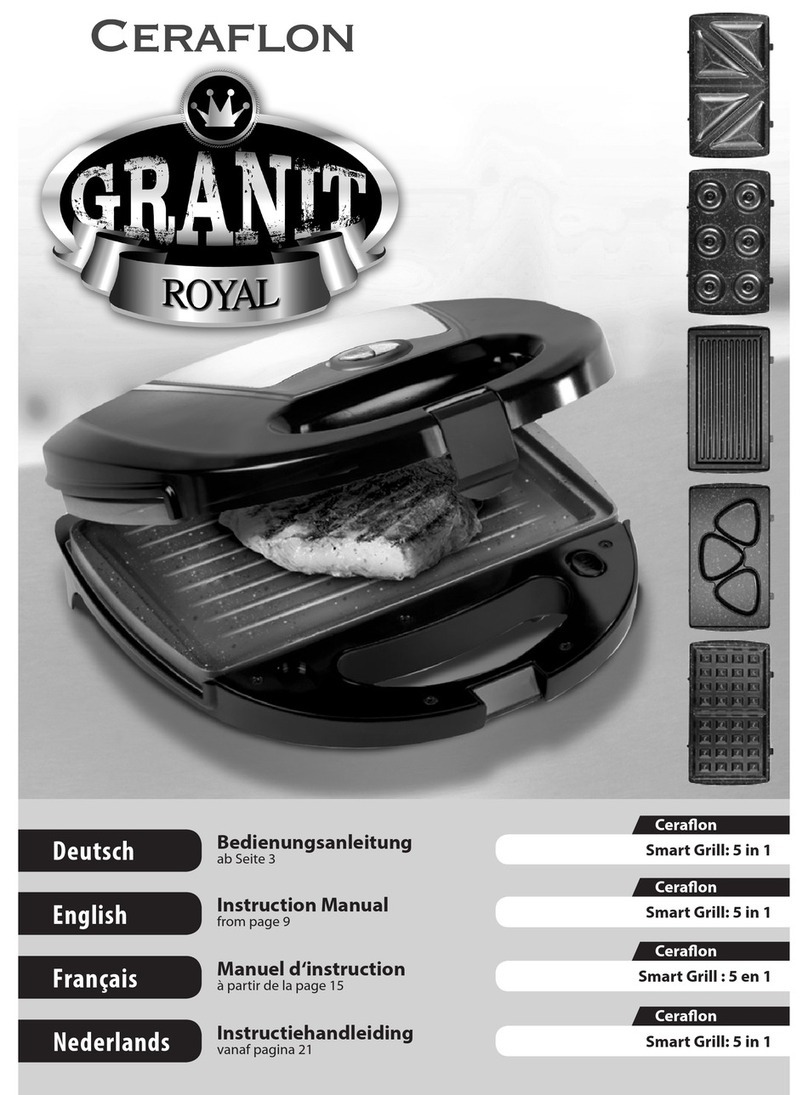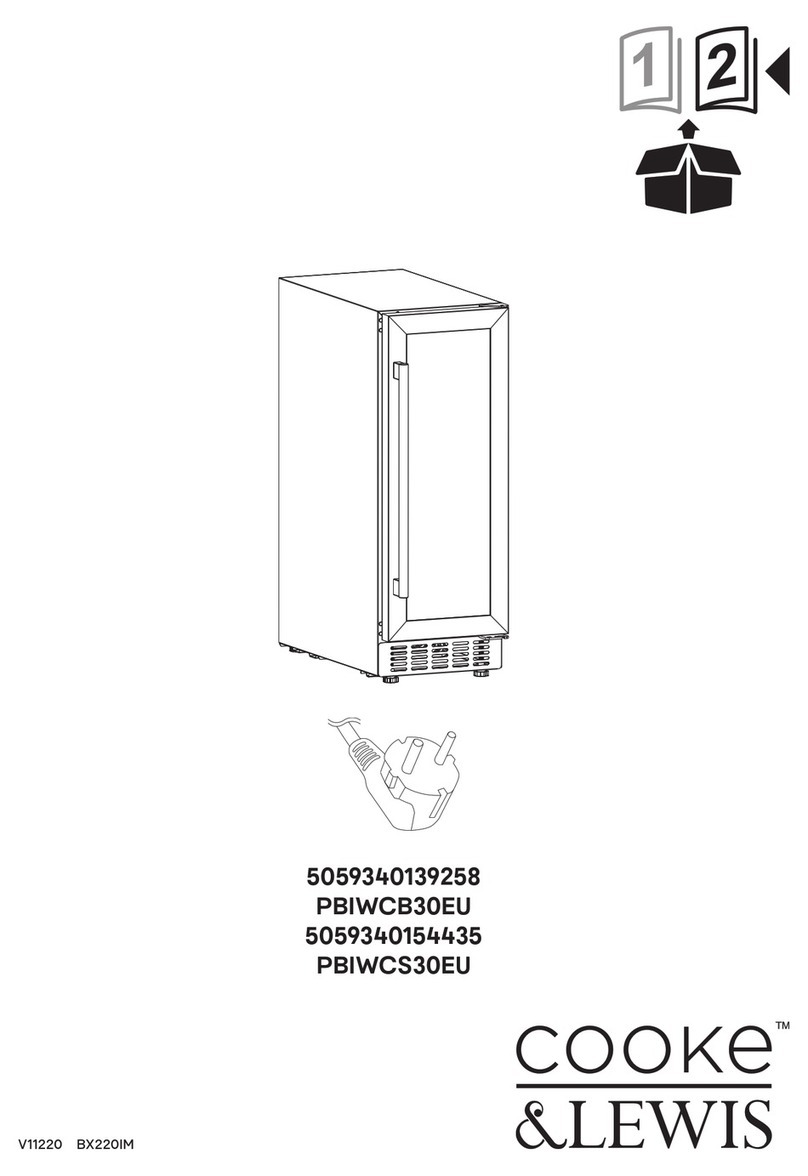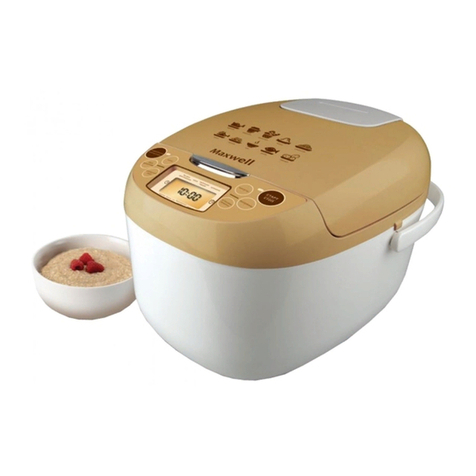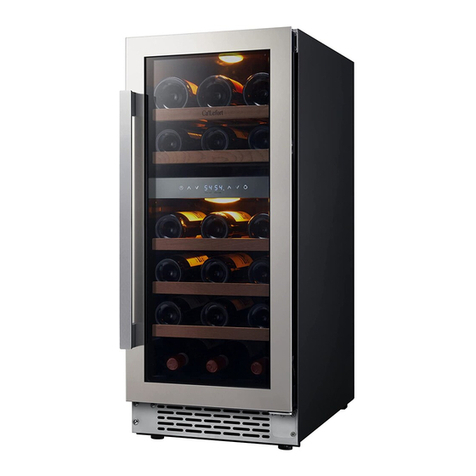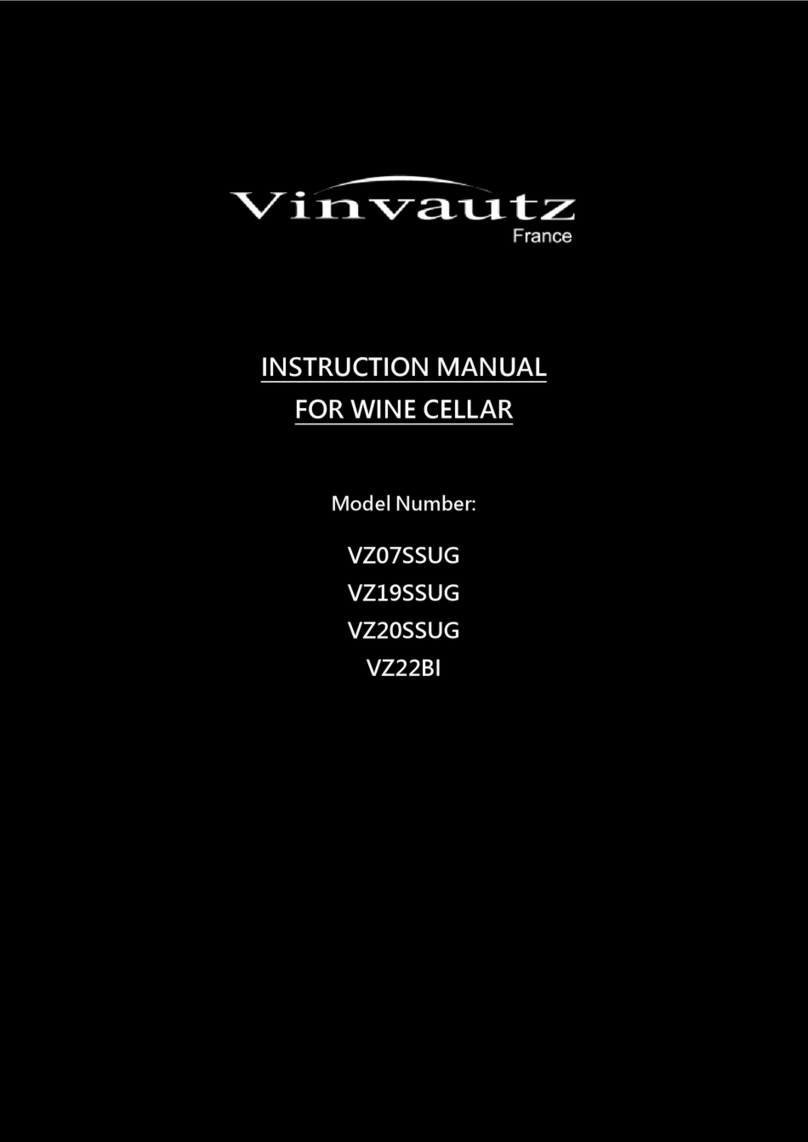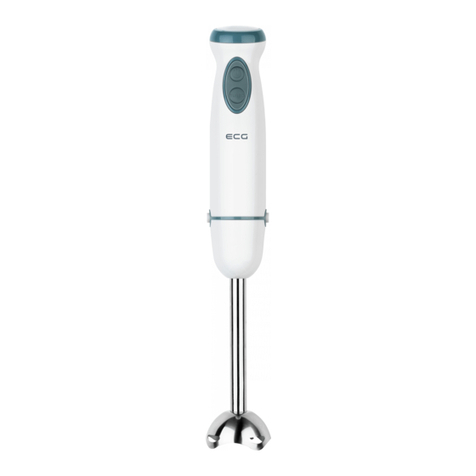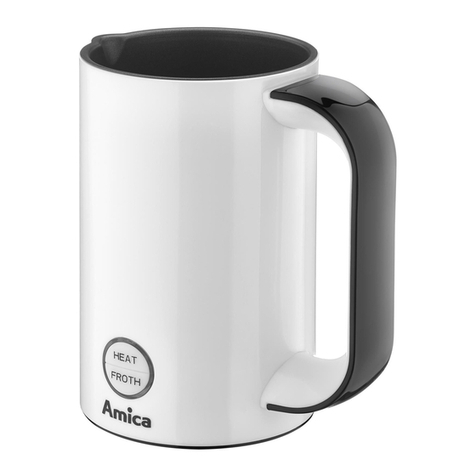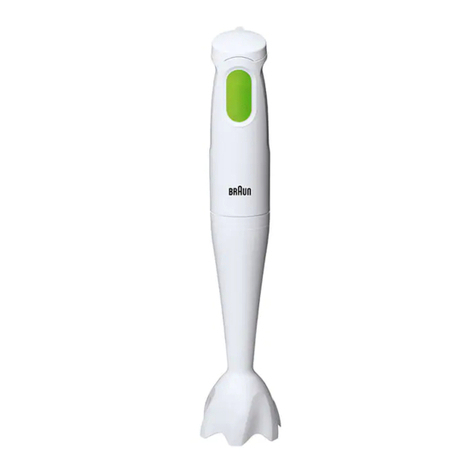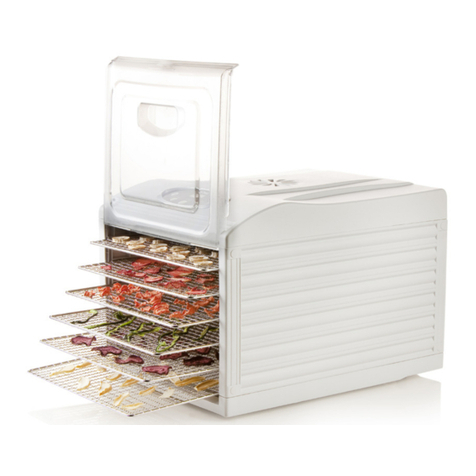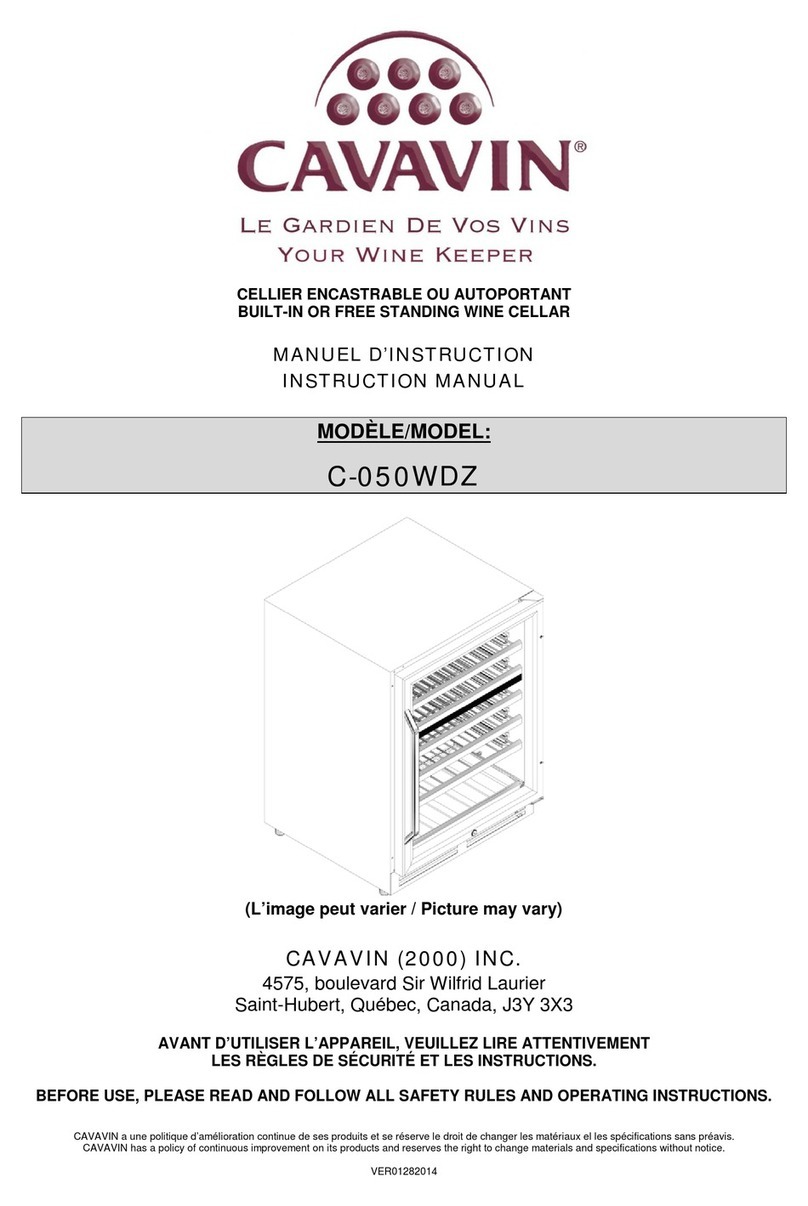Dito Sama 600418 User manual

Refer to the numbered drawings that relate to the numbered paragraphs
in the instruction manual
GB
1 TR2S GB 02 2017
Contents
Introduction 1
Installation 1
Use and safety 3
Cleaning, hygiene and storage 5
Fault-finding 5
Maintenance 6
Compliance with regulations 7
Parts list - exploded view A
Electrical diagrams C
05/2019
Introduction
The User Manual contains useful information for
the user on how to work correctly and in complete
safety, and is designed to make it easier to use the
machine (called “machine” or “appliance” below).
What follows is in no case intended to be a long list of warnings
and constraints, but rather as a series of instructions meant to
improve the service provided by the machine in every respect,
and particularly to avoid a series of injuries or damage to equi-
pment that might result from inappropriate procedures for use
and management.
It is essential that all the people responsible for transporting,
installing, commissioning, using, maintaining, repairing or
dismantling the machine should consult this manual and read
it carefully before proceeding with the various operations, in
order to avoid any incorrect or inappropriate handling that
might be result in damage to the machine or put people’s
safety at risk.
It is just as important that the Manual should always be avai-
lable to the operator and it should be kept carefully where the
machine is used ready for easy and immediate consultation in
case of any doubt, or in any case, whenever the need arises.
If after reading the Manual, there are still any doubts concerning
how to use the machine, please do not hesitate to contact the
Manufacturer or approved After Sales Service provider, who
is constantly available to ensure quick and careful service for
improved machine operation and optimum efficiency.
Note that the safety, hygiene and environmental protection stan-
dards currently applicable in the country where the machine is
installed must always be applied during all phases of machine
operation. Consequently it is the user’s responsibility to ensure
that the machine is operated and used solely under the optimum
safety conditions laid down for people, animals and property.
The reference language for these instructions is French.
• Read the instruction manual carefully before using the
appliance.
• Keep the instruction handbook for future reference.
• Install the appliance in a well-ventilated place
sos
• Place emergency telephone numbers in a visible
position.
• Installation and maintenance must only be carried out
by qualified personnel authorised by the manufacturer. For
assistance, contact an authorised service centre.Demand
original replacement parts.
• The appliance must not be used by people (including
children being supervised not to play with the appliance)
with limited physical, sensory or mental abilities or without
experience and knowledge of it, unless instructed in its use
and supervised by those responsible for their safety.
• The appliance must be used by trained personnel about
the risks involved.
• Do not leave the appliance unattended when operating.
• Turn the appliance off in case of fault or poor operation.
• Do not use products (even if diluted) containing chlorine
(sodium hypochlorite,hydrochloric or muriatic acid,etc.) to
clean the appliance or the floor under it. Do not use metal
tools to clean steel parts (wire brushes or Scotch Brite type
scouring pads).
• Do not allow oil or grease to come into contact with
plastic parts.
•
Do not allow dirt, fat, food or other residuals to form depo-
sits on the appliance.
• Do not clean the appliance with direct jets of water.
• This handbook is available in digital format by contacting
the dealer or reference customer.
• Install a circuit breaker ahead of the appliance.The contact
opening distance and max.leakage current must comply with
the regulations in force.
• The appliance must be earthed; Connect to appliance to an
earth; it must be included in an equipotential node by means
of the screw located under the frame. The screw is marked
with the symbol .
• It is advisable to have the appliance inspected by an au-
thorised person at least every 12 months. For this purpose,
it is advisable to stipulate a servicing contract.
•
Persons wearing pacemakers should see a doctor
to know if their safety is guaranteed near this type of
appliance.
• The symbol given on the product indicates
that it should not be considered domestic waste, but
must be correctly disposed of in order to prevent any
negative consequences for the environment and the
health of persons.For further information regarding
the recycling of this product, contact the product
agent or local dealer, the after-sales service or the
local body responsible for waste disposal.
• The symbol « Read operator’s manual» indicate
that the operator’s manual should be read before continuing
the operation.
• If the supply cord is damaged, it must be replaced by the
manufacturer, its service agent or similarly qualified persons
in order to avoid a hazard.
Failure to observe the above can compromise the safety of the appliance. Failure
to observe the above invalidates the waranty.

The Manufacturer declines any liability for damage and malfunctioning caused by:
•
non-compliance with the instructions contained in this manual;
•
repairs not carried out in a workmanlike fashion, and replacements with parts different from
those specified in the spare parts catalogue (the fitting and use of non-original spare parts and
accessories can negatively affect machine operation and invalidates the warranty);
•
operations by non-specialised technicians;
•
unauthorised modifications or operations;
•
inadequate maintenance;
•
improper machine use;
•
unforeseeable extraordinary events;
•
use of the machine by uninformed and untrained personnel;
•
non-application of the current provisions in the country of use, concerning safety, hygiene and
health in the workplace.
The Manufacturer declines any liability for damage caused by arbitrary modifications
and conversions carried out by the user or the Customer.
The employer, workplace manager or service technician are responsible for identifying and choo-
sing adequate and suitable personal protection equipment to be worn by operators, in compliance
with regulations in force in the country of use.
Electrolux Professional declines any liability for inaccuracies contained in the manual, if due to
printing or translation errors.
Any supplements to the installation, use and maintenance manual the Customer receives from the
Manufacturer will form an integral part of the manual and therefore must be kept together with it.
RECIPIENTS OF THE MANUAL
This manual is intended for:
•the carrier and handling personnel;
•installation and commissioning personnel;
•the employer of machine users and the workplace
manager;
•operators for normal machine use;
•specialised technicians - after-sales service.
TRANSPORT, HANDLING AND STORAGE
Transport (i.e. transfer of the machine from one place to
another) and handling (i.e. transfer inside workplaces)
must occur with the use of special and adequate means.
DISPOSAL OF PACKING
The packing must be disposed of in compliance with the
current regulations in the country where the appliance
is used. All the packing materials are environmentally
friendly. They can be safely kept, recycled or burnt in an
appropriate waste incineration plant. Recyclable plastic
parts are marked as follows:
PE
polyethylene: outer wrapping, instruction
booklet bag
PP
polypropylene: straps
PS
polystyrene foam: corner protectors
The parts in wood and cardboard can be disposed of,
respecting the current regulations in the country where
the machine is used.
PERSONAL PROTECTION EQUIPEMENT
Given below is a summary table of the Personal
Protection Equipment (PPE) to be used during the
various stages of the machine’s service life.
Stage
Protective
garments
Safety
footwear
Gloves Glasses Safety
heimets
Transport
Handling
Unpaccking
Assembly
Normal use
Adjustments
Routine
cleaning
Extraordina-
ry cleaning
Mainte-
nance
Dismantling
Scrapping
Key: PPE REQUIRED
PPE AVAILABLE OR TO BE USED IF NECESSARY
PPE NOT REQUIRED
During Normal use , gloves protect hands from contact
with hot food or hot parts of the appliance.
KEEPING THE MANUAL
The manual must be carefully kept for the entire life of
the machine, until scrapping.The manual must stay with
the machine in case of transfer, sale, hire, granting of
use or leasing.
PE
PP
PS
2
TR2S GB 12 2017

General safety rules
The machines have electric and/or mechanical safety devices for protecting workers and the machine
itself.
Therefore the user must not remove or tamper with such devices.
The Manufacturer declines any liability for damage due to tampering or their non-use.
ATTENTION
Do not use the machine without the guards or with the protection devices deactivated.
Improper use is any use different from that specified in this manual. During machine operation, other
types of work or activities deemed improper and that in general can involve risks for the safety of opera-
tors and damage to the appliance are not allowed.
Reasonably foreseeable improper use includes:
•
lack of machine maintenance, cleaning and periodical checks;
•
structural changes or modifications to the operating logic;
•
tampering with the guards or safety devices;
•
failure to use personal protection equipment by operators, specialised technicians and maintenance
personnel;
•
wrong machine installation;
•
placing in the machine any objects or things not compatible with refrigeration, freezing or preservation,
or that can damage the machine, cause injury or pollute the environment;
•
climbing on the machine;
•
non-compliance with the requirements for correct machine use;
•
other actions that give rise to risks not eliminable by the Manufacturer.
Maintenance intervals :
The inspection and maintenance intervals depend
on the actual machine operating conditions and
ambient conditions (presence of dust, damp, etc.),
therefore precise time intervals cannot be given. In
any case, careful and periodical machine mainte-
nance is advisable in order to minimise service
interruptions.
It is advisable to stipulate a preventive and scheduled
maintenance contract with the After-Sales Service.
Maintenance frequency
To ensure constant machine efficiency, it is advi-
sable to carry out the checks with the frequency
given in the following table :
Maintenance, inspections, checks and cleaning Frequency
Routine cleaning
general cleaning of machine and surrounding area daily
Mechanical protection devices
check their condition and for any deformation,
loosening or removed parts monthly
Control
check the mechanical part, for cracks or
deformation, tightening of screws: check the
readability and condition of words, stickers and
symbols and restore if necessary yearly
Machine structure
tightening of main bolts (screws, fixing systems,
etc.) of machine yearly
Safety signs
check the readability and condition of safety signs yearly
Electrical control panel
check the electrical components installed inside
the electrical control panel. Check the wiring
between the electrical panel and machine parts. yearly
Electrical connection cable and plug
check the connection cable (replace if necessary)
and plug yearly
General machine overhaul
check all components, electrical equipment, yearly
A reproduction of the marking or data plate on the machine is given below:
The meaning of the various information given on it
is listed below:
F..............factory description of product
Model......commercial description
PNC.........production number code
V...............voltage+phase
Hz............power supply frequency
Kw............max.power input
A..............current absorption
IP 23........dust and water protection rating
CE...........CE marking
When installing the appliance, make sure the elec-
trical connection is carried out in compliance with
that specified on the dataplate.
3 TR2S GB 12 2017
ϱϬϲϬ
ɩ
ϯϴϬͲϰϰϬ
ϲϬϬͲϳϱϬ
ϯ
ś

1.1
2.1
2.1
Introduction
1.1DESCRIPTION
This multi-purpose vegetable slicer is used for slicing, fine slicing,
stripping, grating, cutting into chips and cubes various food
products (preparation of crudités, vegetables, fruits, cheeses,
etc.).
With its varied cutting equipment which provides high hourly
outputs, this is the professional vegetable slicer for restaurants,
community kitchens and small industries.
APusher
BRam
C Hopper
DCasing
EBase
FStand
GBody
H Control panel
I Locking pin
J Interruptor
Installation
2.1DIMENSIONS - WEIGHT (INDICATION ONLY)
• Packaging dimensions in mm:
L: 580 W: 300 H: 600
• Appliance dimensions:
• Appliance weight:
ATTENTION!!
Machine storage: -25°C to +50°C
Ambient temperature during operation: +4°C to +40°C
This machine is for professional use and must be used by staff trained to use, clean and maintain it, in terms or reliability and
safety.
Use the machine in adequately lit premises (See applicable technical standard for the country of use. In Europe, refer to standard
EN 12464-1)
When handling the machine, always check that the parts taken hold of are not mobile elements: risk of dropping and injury to the
lower limbs.
The machine is not designed for use in explosive atmospheres.
2.2
2.2POSITION AND ORGANISATION
• On a table of a maximum height of between 700 and 900 mm,
the vegetable slicer takes a standard tub of a max. height of
200 mm.
• On a functional moveable base (supplied as an option).
• With tubs of large dimensions, place the vegetable slicer on
the table edge or use the moveable base.
4
TR2S GB 12 2017

- Change the integral plate wire by moving the cable connection
terminal marked as upper voltage (400V) onto that marked as
lower voltage (230V).
- Change the motor wire connections (see electrical diagram).
- Refit the casing, then check the direction of rotation.
2) Single phase motor.
A standardised 2-pole + Earth wall socket rated at 10/16A will
be required.
• Warning to the installer:
This electronic variable-speed vegetable slicer is fitted with an
integral filter without going via the variator. To be effective, the
system’s earth must be of good quality, otherwise interference
may pass via the variator and damage it.
• No earth connection = no protection = risk of failure +
DANGER for the user!
Note: The earth values are defined according to the residual
differential current and must be checked by an electrician.
To PAT test the Electrolux Range of Food Preparation Equipment,
the PCB board needs to be disconnected before any test is done.
This is due to the fact that the boards are fitted with a grounding
diode that can give incorrect result during such a test. Also on
a standard appliance a flash test of 25 amps and up to 3000v is
used but, as you would expect, to use this on equipment, which
has a printed circuit, board would be quite destructive to that
board. We would recommend the use of a PAT tester approved
for computer systems which use a lower rate of amps.
The appliance is perfectly safe and is CE certificated. There are
two ways to get overcome this problem.
· Disconnect the board as instructed and test using test for PC’s,
· Or install the mixer on a fused spur (no plug) as this takes it
away from being a portable appliance and the PAT test is then
not needed.
•
Check that the electric mains voltage and the value shown on the
specification plate and the label on the power cable are the same.
• The machine must be protected by a residual current device
(RCD) and a fuse of a rating shown in column F of the specifi-
cations.
• Motor specifications:
ANumber of phases (1 single phase or 3 three-phase)
BNominal voltage in volts (value, range or commutation)
CFrequency (Hertz)
DNominal rating (Watts)
E Nominal current (Amperes)
FRating of the fuse protecting the electric line
(Amperes)
1) Dual-voltage three-phase motor.
• A standardised 3-phase + Earth wall socket rated at 20A will
be required and a relevant sealed plug to be fitted onto the power
lead.
• Check the direction of rotation with the ejector fitted in the
machine.
- Remove the pusher after unlocking it (anti-clockwise direction
).
- Press the "On" button.
- Make a visual check on the ejector's rotation via the pusher
tube. The ejector should turn in an anti-clockwise direction
.
• If the direction of rotation is reversed, change over the 2 phase
wires on the power socket.
• Connection is made at the upper voltage (e.g. 400V).
To connect at a lower voltage, (e.g. 230V), proceed as
follows:
- Disconnect the appliance and turn it over.
- Remove the 4 case retaining screws.
2.3
Must be earthed with a green/yellow wire.
2.3ELECTRICAL CONNECTION
ATTENTION!!
Connection to the electrical power supply must be done according to proper professional practice by a qualified and authorised
person (see current standards and legislation in the country of installation).
If an adapter is used on the socket, a check must be made that the electrical characteristics of this adapter are not lower than
those of the machine.
Do not use multiple plugs
The AC power supply to the machine must comply with the following conditions;
- Maximum voltage variation: ±5%
- Maximum frequency variation: ±1% on a continuous basis, ± 2% over short periods
ATTENTION: the electrical installation must comply (for design, creation and maintenance) with the legal and standard
requirements in the country where used.
-
Check that the electric mains voltage, the value shown on the specification plate and the label on the power cable are the same.
- The machine’s electrical power supply must be protected against voltage surges (short-circuits and excess voltages) by using
fuses or thermal relays of the appropriate gauge relative to the place of installation and machine specifications – see the spe-
cifications shown in column F of figure 2.3a
- Disconnection incorporated in the fixed wiring is to be provided.
ATTENTION: Concerning protection against indirect contact (depending on the type of power supply provided and
connection of the exposed conductive parts to the equipotential protection circuit), refer to point 6.3.3 of EN 60204-1 (IEC
60204-1) with the use of protection devices for automatic shut-off of power in the event of an insulation fault with a TN or
TT, system, or for the IT system, with the use of a permanent insulation or differentials controller for automatic shut-off.
The requirements of IEC 60364-4-41, 413.1 must apply for this protection.
For example: in a TT system, a differential circuit breaker must be installed upline of the power supply, with a suitable
power cut-off (e.g.: 30 mA) on the earthing installation for the place where it is planned to install the machine.
ATTENTION :
In order to avoid a hazard due to inadvertent resetting of the thermal cut-out,this appliance must not be supplied
through an external switching device, such as a timer ,or connected to a circuit that is regularly switched on and off by the utility.
ATTENTION: Failure to comply with these instructions means the customer runs the risk of machine failure and/or acci-
dents due to direct or indirect contacts.
5TR2S GB 02 2018
Damage caused by a lack of earth will not be
covered by the warranty
Must be earthed by green/yellow wire.
In certain cases, depending on the sensitivity of the
protective RCD, SI-type (Super Immunity) devices may
need to be fitted to prevent unwanted tripping.

Use and safety
Clean the machine properly prior to its first use
Uncontrolled closure of the lid or ram press involves a risk of crushing the fingers.
Never put a hand in the ejection area while the machine is in operation; risk of injury. It is strictly forbidden to put the safety systems
out of action or modify them: Risk of permanent injury!!!!
Check that the safety devices operate correctly each time before using (see paragraph on «safety system adjustments»).
Never put a hand, a hard or frozen object
into the hopper with the machine on.
For health and safety reasons, always use a washable or disposable strong head covering that covers the hair completely.
ATTENTION: All operations, whether using, cleaning or maintenance, present risks of cuts; never force and always keep
hands a reasonable distance from cutting edges.
Always use appropriate protective equipment when carrying out these operations.
ATTENTION!!
- Cheese: Gruyere and mozzarella.
- Other: walnuts, almonds, breadcrumbs, chocolate, etc.
• P: For parmesan, breadcrumbs, almonds, black radish and
chocolate.
• K: Special grating of raw potatoes (Knödeln).
• FT chip grids: 6 to 10 mm thick cut when combined with a CP/
CPW plate of the same thickness.
• MT dicing grid: cutting into 5 to 20 mm square
sections when combined with a CP/CPW plate for:
- Cubes or parallelepipeds: diced vegetables or fruits, mixed
diced vegetables, minestrones, sautéed or deep-fried potatoes
and soups.
To use the MT05 grid, only the small hopper with removable
pusher should be used.
Indication of output (kg / hr):
Crisps with C 2 S 250
3.2CHOICE OF CUTTING EQUIPMENT
• C slicer plates: 1 to 13 mm straight cut.
• CW slicer plates: 2 to 10 mm crinkle cut for:
- Vegetables: potatoes, carrots, aubergines, beetroot, celery,
cabbage, mushrooms, cucumbers, courgettes, chicory, fennel,
onions, leaks, radish, etc.
- Fruits: almonds, bananas, apples, etc.
• ASX stripping plates: cutting into 2 to 10 mm sticks.
- AS 2X: fine 2 x 2 mm
- AS 3X: medium 3 x 3 mm
- AS 4X: large 4 x 4 mm for matchstick potatoes
- AS 6X
- AS 8X
- AS 10X
- AS 2X8X : tagliatelles 2x8 mm
- AS 2X10X : tagliatelles 2x10 mm
• J - P - K grater plates
• J2 fine J3 medium J4 large J7 very large J9 very large.
- Vegetables: carrots, “straw“ potatoes, celeriac salad, red
cabbage, beetroot, black radishes, horseradish and rœsti.
3.2a
3.2c
3.2d
patatas paja,
apio, zanahoria
}
3.2e
3.2f
3.1THE USER'S SAFETY IS GUARANTEED BY:
- A motor break who stop the appliance when the lever-ram is
opened to avoid cutting risk.
- The impossibility to start the motor without the hopper and the
lever in place.
- The dimensions of the long vegetable small hopper.
- The design of the cutting chamber, the ejector and the cutting
tools to avoide crushing issue.
- Cleaning and maintaining routine discribed in the user manual.
- Thermal protectors for overheating risk.(See §6.3)
Potatoes C 3 S 300
Grated carrots J 3 250
Chips C 10PS+ FT 10 500
Sautéed potatoes C 13PS + MT 20 600
Diced vegetables C 8PS + MT 8 450
6
TR2S GB 12 2017
Any other use than that described in this manual will
not be considered normal by the manufacturer.
The manufacturer declines any liability for improper
use of the product.

3.3SETTING UP / USING
• Before use, connect the appliance and set the switch to On.
• The vegetable slicer is supplied with the ejector fitted on the
drive shaft. Press the cover latch upwards and raise the cover
up to the clip stop to remove the ejector.
Before starting any work, always make sure the cutting chamber,
the drive shaft, the ejector, the plate and the grid are clean.
1) For slicing, thin slicing, grating and stripping
• Fit the cutting chamber.
• Fit the ejector onto the drive shaft flat.
• Install the required plate (slicer, stripper or grater).
- Turn the plate in a clockwise direction to find the bayonet
opening, then continue in the same direction until the pin stop.
- Close the cover and make sure it is locked.
- To remove the plate, turn in the opposite direction and raise
it. If it remains stuck, see § 5.3.
2) For cutting chips or cubes
• Fit the cutting chamber.
• Fit the ejector (see § above).
• Place the chosen grid in its housing making sure that it does
not wobble (cleanliness of the supports).
• Then install the chosen plate and close the cover.
3.3
There is a risk of cuts with all these ope-
rations. Never force and keep the hands
at a reasonable distance from the knives.
3.2c
• Recommendation: For cutting products of different hardnesses
with an MT grid, start by cutting the soft products, as these cannot
push cubes of hard products held in the grid. For hard products of
the carrot or celery type, or very adherent products of the cheese
type, it is recommended that the small hopper is used.
3) Operating
• Control panel:
A"Off" button.
B1 speed "On" button
CPulse-operation "On" button
D 2 speed "On" button
E - F Speed selection button. Variable-speed model.
GSpeed display.
The slicer can be operated if:
- the hopper is locked
- the ram is lowered
a) Continual operation:
- start by pressing B: speed 1
- start by pressing D: speed 2 (depending on model)
b) Pulse operation:
- start by pressing C
c) Variable speed:
- Speed selection on G by pressing buttons Eand F.
Note:
In the event of a prolonged stop over several days, disconnect the
appliance so that the electronic variable speed unit is not left live.
d) Stopping:
- Button Amust be used when the work is finished.
The vegetable will only operate if the cover is closed.
- Keep the pusher inside of the lever-ram as this prevents pro-
ducts from coming back up.
- Press the ON button.
- Raise the lever-ram
- When the ram comes out of the hopper, the motor immediately
stops, which means that products can be changed in complete
safety.
-
On lowering the lever, the vegetable slicer starts automati-
cally.
3.4HOPPER SELECTION AND FUNCTIONS
1) Large hopper with hinged lever-ram.
ACutting into slices B Stripping CGrating
- Processing large dimension products
(Maximum 160 x 80 mm, corresponding to 1/4 cabbage).
• Manual loading is by introducing the products either singly or
in handfuls, making sure they are correctly positioned to prevent
any incorrect cutting. Rest "delicate" products (tomatoes, citrus
fruit, etc.) against the side wall.
2) Small hopper with removable pusher.
• For cutting long products into slices (carrots, chicory, cucum-
bers, leaks, etc.) maximum opening Ø 52 mm.
3.4a
Never introduce the hand or a hard body into the
hopper with the machine on.
3.4b
3.4c
3.5a
3.5c
3.5b
3.6
For cutting into slices, always present long products by their
tips.
• Manual loading is by introducing the products vertically into
the small hopper, either singly or in handfuls.
• Recommendations to prevent:
- A sloping, uneven cut: arrange fine products "head-to-tail".
- Jamming: cut the vegetable ends.
3.5 USING THE LARGE HOPPER AND THE LEVER-RAM
For thin slicing and slicing.
- Using the lever-ram, follow the products into the hopper as far
as the lower stop, using gradual force on the lever-ram.
- Raise the lever-ram and start a new cycle.
- When the work is finished, press the OFF button.
Note: Use gradual force to follow through with the lever-ram
depending on:
- the product to be processed (soft product = light force),
- the cutting equipment selected (a grater requires more force
than a slicing plate).
Do not press too hard to avoid overheating the machine.
3.6USING THE SMALL HOPPER AND THE PUSHER
- Leave the lever-ram in the down position and unlock the
pusher.
- Press the ON button to start.
- Remove the pusher with one hand and load the products with
the other.
- Push the products with the pusher and start a new cycle.
- When the work is finished, press the OFF button.
7TR2S GB 05 2019
3.3a

Unlock the pin by pulling it out approximately 2 cm.
Lower the ram to facilitate withdrawal of the assembly.
Completely remove the pin.
The hopper-cover and cover-ram assembly can be wi-
thdrawn.
- Wash the equipment in hot water, rinse and dry.
- Clean the body with a clean, damp sponge.
• The cutting chamber, hopper and lever-ram can be washed
in a dish-washer.
4.1BETWEEN TWO SESSIONS
- Remove the cutting equipment (plate, grid and ejector) and
the pusher.
- Remove the cutting chamber.
- Remove the hopper-cover and the lever-ram, following the
instructions below:
Raise the ram up to the clipped position.
(This is the only position in which the pin can be locked/un-
locked).
4.3STORAGE
- After cleaning, put all the cutting equipment away carefully in
the storage case fixed to the wall.
-
Clean the outside of the vegetable slicer with a damp sponge
and a mild detergent and then rinse using a clean sponge.
Note:
- Do not use abrasive detergents as these scratch the surfaces,
or bleach-based detergents as these tarnish the aluminium.
4.2AFTER USE
- Refer to § 4.1.
- Clean the removable elements in hot water with the addition
of detergent-degreaser-disinfectant which is compatible with
the materials.
- Rinse with clean water and leave to dry.
Recommendation: for MT grids, push any trapped cubes using
a carrot. Metal instruments are not to be used.
4.2
4.1
4.3
Cleaning, hygiene and storage
ATTENTION!!
Before dismantling any part, disconnect the appliance from the power supply.
Before using any cleaning product, be sure to read the instruction and safety instructions accompanying the product and
use appropriate protective equipment.
Do not wash the machine using a pressure washer, a spray or by immersion
Take care when handling screens and plates. (Risk of CUTS – ELECTRIC SHOCK).
- With the other hand, hold the plate on the outside and using the
finger grips turn sharply in an anti-clockwise direction .
- Raise it using a to-and-fro rotation movement.
5.3JAMMED PLATE:
- Unplug the appliance.
- Place one hand flat on the ejector and stop it rotating.
5.3a 5.3b
Fault-finding
5.1IF THE APPLIANCE WILL NOT START, CHECK THAT:
• The machine is plugged in, the main switch is turned On.
• The electrical power supply to the socket is correct.
• The hopper is properly locked.
• The lever-ram is down.
• The pin is fully pushed.
• If the appliance does not work after all those check, follow the
thermal switch check procedure (see § 6.3).
5.2ABNORMAL NOISE:
• Stop the appliance.
• Check that the plate, grid and ejector are properly in place.
• Remove, clean if necessary and refit.
• If the noise persists and the appliance lacks power, check
that:
- The three-phase motor is not running on 2 phases.
- The drive belt is not worn or needs tightening (see § 6.1).
8
TR2S GB 12 2017
1.1

6.1MECHANISM
• The vegetable slicer requires only minimum maintenance (the
motor and mechanism bearings are greased for life).
• It is recommended that the tension and wear of the drive belt
is checked at least once a year.
To check it, proceed as follows:
- Turn the appliance over.
- Remove the 4 casing retaining screws
• To tighten the drive belt
- Unscrew (1 turn) the 3 motor support retaining screws A (10
mm pipe wrench) .
- Use a screwdriver as a lever between the pulley and the motor
support plate.
-
Tighten the 2 screws located at the front of the motor support.
- Check the drive belt tension by pressing on it between the
motor support and the large pulley with the thumb. A deflection
6.1
Residual voltage at the capacitor terminals.
Unplug the machine before carrying out any operation.
Maintenance may only be carried out by persons who are qualified, trained and authorised and demand original replacement parts.
Maintenance
of approximately 3 mm is sought.
- Tighten screw A located at the rear of the motor support.
- Remove any drive belt particles found on the inside of the
casing.
- Check the condition of the electrical connections.
- Refit the casing.
• Access to the electrical components:
- Disconnect the machine.
• The capacitors may remain electrically charged.
In order to avoid any risk when working on the machine, it is
recommended that they are discharged by connecting across
their terminals with an insulated conductor (a screwdriver, for
example).
6.2 MAINTENANCE OF THE CUTTING EQUIPMENT
• Slicer plates: sharpening the knives
• Chip grids.
The blades cannot be changed as they are mould-cast and
tensioned for life.
- Rework the blade wire where necessary using a soft stone.
• Dicing grids.
The blades cannot be changed as they are mould-cast and
tensioned for life.
- Rework where necessary using a small file if the blades have
been damaged after a blow.
• Graters.
The graters cannot be sharpened.
-
If there is significant wear in the grater holes, change the fitting.
5.4 WORK QUALITY
• Stop the machine before starting any work on it.
• If the products are not being ejected properly, check that:
- The ejector is fitted properly.
- Products in the reception tray are not obstructing the outlet.
- There is no accumulation of products in the cutting chamber.
• If the cutting is not of sufficient quality, check:
- The direction of rotation (anti-clockwise seen from above).
If the incident persists, contact your local dealer's service
department.
- The correct speed has been selected (depending on model).
- The correct cutting equipment has been selected (see § 3.2).
- The condition of the cutting equipment.
- The choice of hopper.
- The presentation of the products in the hopper (see § 3-4)
6.3
6.3ADJUSTMENT OF THE SAFETY DEVICES
• The correct operation of the motor brake safety devices should
be checked frequently. The motor should stop in less than 2
seconds:
- On opening the hopper. The motor should not start if the hopper
is not properly closed (latch clipped),
- On raising the lever-ram, dimension F at max. 45 mm from the
edge of the hopper.
•
If the appliance suddenly stop during workin operation
and does not restart, it might be an overheating issue.
Follow the procedure here:
- Wait 30 minutes cooling down with the appliance
turned off.
- Try to restart the appliance after the 30 min.
- For 1speed: If the appliance still does not start, call
the technical maintenance to re-engage the thermal
protector inside the appliance.
- For other versions : If the appliance still does not start,
call your dealer's service departement.
• If either of the safety functions does not work:
- Do not use the appliance.
- Make it adjusted by your dealer's service department.
9TR2S GB 12 2017
Always disconnect the machine before any intervention on it.
6.4

The machine has been designed and manufactured in com-
pliance with:
- conforme to IEC 60335-1
- conforme to IEC 60335-2-64
- CISPR 14-1 (Fifth Edition) + A1 + A2
- CISPR 14-2 (second Edition)
- IEC 61000-3-2 (Fourth Edition)
- IEC 61000-3-3 (Third Edition)
6.5ADDRESS FOR SERVICE REQUIREMENTS
We advise you first to contact the dealer who sold you the machine.
The manufacturer reserves the right to modify and make impro-
vements to its products without notice.
10
TR2S GB 12 2017
Dealer's stamp
Date of purchase: ...............................................
For any requests for information or orders for spare parts,
specify the type of machine, the serial number and the
electrical specifications.
Compliance with regulations
6.4ELECTRICAL COMPONENTS
See electrical diagram.
• Wire colour identification:
- Power circuit : (F) black
- Control circuit : (A) red
- Motor : U1 - V1 - W1
- Phases : L1 / L2 / L3
- Neutral : N
- Earth : B/C yellow/green.
• Component identification:
- C.C. : Control card
- S2 : Hopper safety device
- S3 : Temperature sensor (depending on model)
- S5 : Ram safety device
- M : Motor
- C.Pu. : Power card
- B1 : Terminal block
- C D : Start capacitor
- C P : Running capacitor
- C b : Brake capacitor
- K1 : Start relay
- V : Variable speed control
- Fur : Spare fuse
- X : Power supply cord
- KM1...: Contactor
- H1,H2... : Connecting housing
- Q1 : Thermal switch
This manual suits for next models
5
Table of contents
